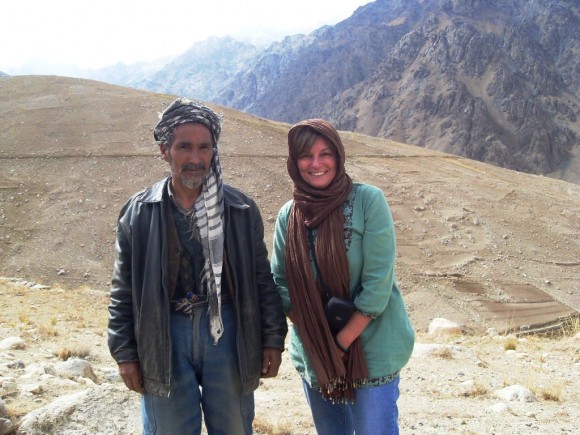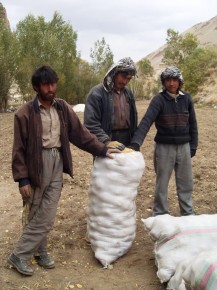Bamyan is a beautiful province in Afghanistan and home to the Hazaras, an ethnic Shia minority who make up 9% of the Afghan population. They are believed to be descendants of Genghis Khan's army and have distinctive features. My visit was to see further projects that the UK Government could support in agriculture.
Most of the population are subsistence farmers who grow wheat in small fields and rear sheep and goats to feed their families. The introduction of the humble potato seven years ago has transformed the diets and livelihoods of these farmers. Production has grown rapidly in the province which now grows more than 50% of Afghanistan's potatoes and now the UK is looking to expand its support for agriculture in the province.

Sheep from Yawkalang district in Bamyan are highly prized, but local farmers make little profit from the Kabul traders. The planned project will revitalise farmers' co-operatives to negotiate better prices with traders, and train local people to provide basic veterinary services. During the freezing winter months, livestock has to be kept inside, but the traditional barns, made with mud walls and turf roofs are unventilated. Farmers can lose some of their livestock because of the noxious fumes that build up. I saw an improved barn with glass windows and ventilation shafts in the roof. It cost $700 to build - a large outlay, but the farmer could expect to recoup the investment in two to three years as fewer animals would die over the winter and all would emerge in the spring healthier. Already in the area farmers were copying the barn, knocking holes in their traditional barn walls for windows.
The rangelands where the livestock graze have suffered from over-grazing and soil erosion. Bamyan receives little rain and most of the water comes from snow. In the winter, avalanches are a common hazard, as are floods in the spring. The new programme will aim to address the underlying problems. I saw how, at the top of the mountain ridge, trenches and walls were constructed to hold the snow back and prevent avalanches and floods. The community had also agreed not to graze their animals in certain parts of the rangelands for five years to allow regeneration of grasses and natural vegetation.

After climbing up the mountainside to inspect all these improvements, I was utterly breathless as we were at well over 10,000 feet! The view from the top was incredible, with snow falling on the highest peaks, the huge craggy mountains, and valley after valley unfolding in front of my eyes.
I met some local farmers who followed us up the mountainside. Maryam Ali is 58 years old and has lived in his village all his life. When he was a child, grazing was plentiful and there were many fruit trees - he had never used money.
In recent times, the soil has become poor, grazing is bad and though they have some money, life is hard. He thinks potatoes are a miracle crop. He has helped construct the avalanche and flood-resistant walls to prevent soil erosion and has seen the benefits. The co-operatives would give him access to loans with low interest rates so he can purchase a tractor to plough his fields. In a few years, he feels the pasture lands could be what they were when he was a boy, and he is confident that his children's future is positive.
When I came to Afghanistan I would never have imagined that I would be posing for a photo on the top of a mountain at 10,000 feet with an Afghan farmer. I'm pleased that the UK's investment in Bamyan's agriculture gives Maryam Ali confidence in his and his family's future.

5 comments
Comment by Emily Hickson posted on
Dear Philippa,
Firstly, thank you for a wonderful blog on how DFID money and work is supporting rural livelihoods. Secondly, I was hoping you could help me. I met your colleague Dominic D’Angelo last November when he came to speak at Durham University, where I am a final year International Relations undergraduate student. I spoke to him after his talk about the possibility of securing an interview with a DFID Afghanistan staff member to discuss integrating gender awareness into conflict and post-conflict policy, especially regarding the areas of political participation and security for women. I understand Mr D’Angelo may have been rather busy lately and my follow up e-mails to him never got a reply. I think however, it may have been you he had in mind to talk to me.
Would you be able to spare 10 minutes of your time, either over e-mail or by Skype, to answer three or four questions for my dissertation research? If you could, that would be brilliant and would lead to an outstanding contribution. My e-mail address is e.a.hickson@durham.ac.uk so if you pop me an e-mail I would send you further details.
I really hope to hear from you,
Kind regards,
Emily
Comment by Amin posted on
Dear Philippa
Thanks for visiting our beautiful country and this blog. This kind of positive info will encourage other researchers to get involved in Afghanistan. Afghanistan needs technical staff to disseminate knowledge to the local people in order to put the country on the right track again. The 35 years war has pushed our country to stone age. All what we need is more investment in development, education and health. We are far behind our neighbors.
I have a master in International health from Copenhagen University and want to be involved in development project. If you know someone in your network who can give me opportunity to be involved in any developmental project, it would be a great help for me and our country. Thanks
Comment by Rachel Kasumba posted on
Philippa, thanks for the great news. It is inspiring to see the resilience of these farmers and their positive outlook to the future due to DFID’s contribution. Goes to show that where there is determination, everything is possible and kudos for the positive news out of Afghanistan.
Comment by Thai Blogger posted on
Well, that's a very great news to know and I believe that when others will read this post, they will got inspired.
Comment by Williamscarlet posted on
My visit was to see further projects that the UK Government could support in agriculture. Most of the population are subsistence farmers who grow wheat in small fields and rear sheep and goats to feed their families.